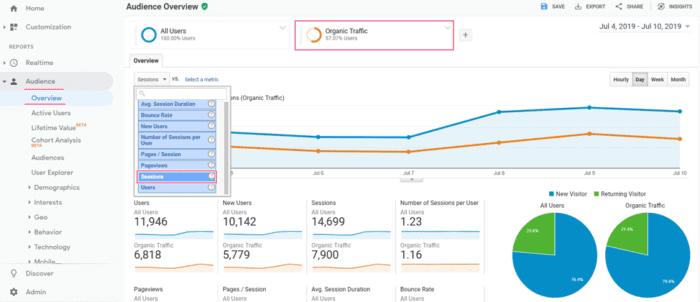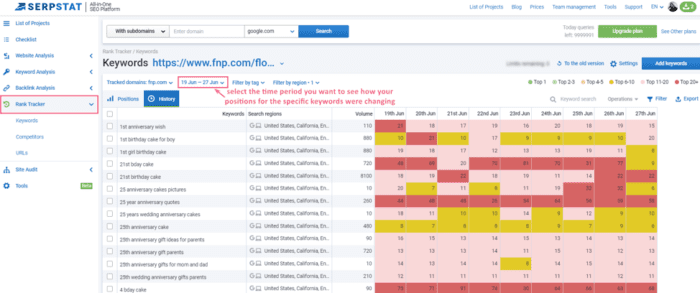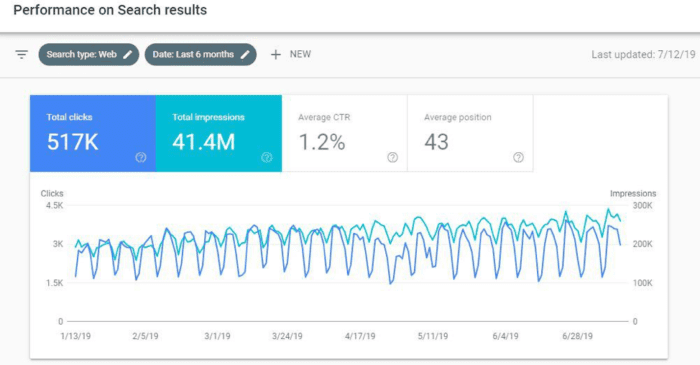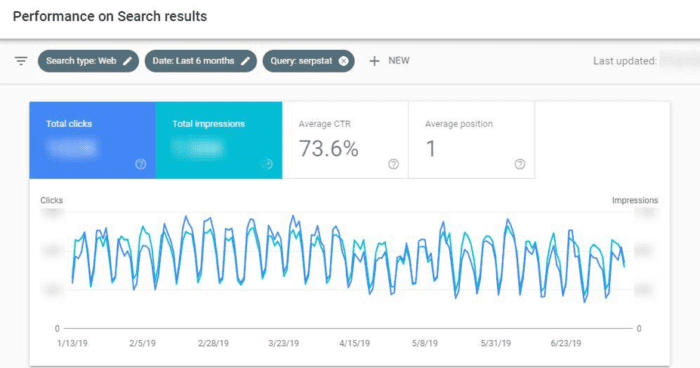Monitoring the right KPIs is the best way to avoid spending time and money on something that isn’t driving the expected profit
Is your SEO strategy effective enough? How can you ensure your efforts drive tangible results? What can you do to develop your website performance?
Tracking the right performance metrics, you’ll be able to answer all these questions.
KPIs work as a control system that lets you identify which tactics work and which don’t. What’s most important, monitoring the right KPIs is the best way to avoid spending time and money on something that isn’t driving the expected profit.
In this article, I’ll highlight 10 critical indicators marketers should pay attention to.
1. Organic traffic
This KPI measures how many visitors come to your website from organic search results.
It’s one of the most important metrics to consider, as its growth denotes you reached the main SEO objective: growing the number of people seeing and visiting your website.
If you work with Google Analytics (and you definitely should), you can easily track daily searches in your site traffic. Go to the ‘Audience > Overview’ report, click on the ‘Add Segment,’ and select the ‘Organic Traffic’ filed.

In the resulting report, you can see how the number of organic sessions changes in time and discover how it correlates with the total sessions.
2. Search rankings
It’s not a secret the higher your website ranks for the relevant keywords, the better.
Search rankings is a crucial KPI because it directly correlates with your SEO success. Once you get the higher search positions, you’re about to reach the other objectives such as traffic, leads, and conversions.
It’s also important to track your rankings for the right keywords. So, if your website ‘Jeans’ section ranks in first place for the ‘black and white vertical striped skinny jeans for women’ query, your site traffic won’t improve significantly.
You can monitor how your search positions for the target keywords are changing with such tools as Serpstat or Ahrefs. All you need to do is to enter your domain, select the type of SERP (you need organic results), import the list of keywords, and start rank tracking.

The reports will provide you with the data on your current positions and how they were changing. Moreover, you can also select competitors’ domains and get reports on their rankings for the tracked keywords.
3. Search visibility
Search engine visibility indicates how often your domain is shown in search results for the keywords it’s ranking for.
Tracking search visibility, you can see the positive dynamics even before your site starts attracting visitors. This score can be a key driver for all your SEO-based activity. Search engine visibility score is extremely useful if you want to monitor the early results of website optimization.
To track the visibility dynamics, you can go with Google Search Console:

In the Performance report, you’ll see the Total impressions score. Every time a user comes to the search results page that contains your URL, an impression is recorded.
4. Links
Links should always be considered as a key SEO metric for content marketers and SEO experts. Backlinks are among the most important factors behind the rankings now. It means that your SEO strategy should be revolving around acquiring links.
So, the more links you earn, the better, right? Not exactly. Gaining low-quality links, you will not only fail to improve your site authority but even hurt your website rankings.
To ensure you’re building a quality link profile, it’s essential to track its quality score. You’ll need one of the backlink analysis tools for this purpose. Among the ones I would recommend you are:
Each of these tools provides link authority index: the higher it is, the better the link is. If you enter your domain, you’ll see the score that estimates the quality of your link profile based on the number and quality of the referring domains.
5. Organic CTR
Click-through rate (CTR) is a performance metric that measures the ratio of clicks on your link to the total number of users who viewed the search results. In other words, high CTR = high traffic.
CTR is also an important search engine ranking signal. For instance, if your search snippets don’t look appealing enough, even high rankings won’t help you attract more visitors. As a result, your CTR leaves much to be desired. Low CTR will tell search robots your site doesn’t meet users’ expectations, which may result in lower rankings.
Focusing on traffic and rankings, people often make a huge mistake overlooking this KPI. Tracking your organic CTR, you can find out why your high impressions don’t result in significant traffic and fix the problem.
To monitor your CTR, go with Google Search Console.
6. Branded traffic
Branded traffic is the traffic that comes from users who searched for the terms that contain your company name. If brand awareness is important for your brand (and it should), branded traffic should be your primary KPI.
As searches already know what they want when searching for the branded keywords, this type of traffic results in the highest conversion rates.
You can track this KPI with Google Search Console:
- Add all the keywords associated with your brand name (including misspelled ones) to the Search Console’s filter.
- Track how the number of total clicks and impressions is changing (or not) in time.

7. Bounce rate
This metric measures the percent of your site visitors who bounced from your website without taking any action.
This is another crucial metric which is considered by the search engines as a ranking factor. Depending on your industry, a typical bounce rate should be between 40-60%. If the percentage is too high, it indicates the page is not relevant to the search query.
Monitor your pages’ bounce rate in your Overview report on Google Analytics to identify which ones result in high rates and try different approaches to see what can help you reduce it.
8. Average session duration
How much time do your visitors usually spend on your website? Do you engage them to stay longer? Average session duration is a prominent metrics you should consider to measure the user engagement on your website.
Monitoring session duration, you’ll be able to assess the quality of your site and understand whether you need to implement any changes into your site structure.
To have a longer session duration, you should build an in-depth content structure: internal linking, breadcrumbs, hamburger menus, etc.
9. Cost per click
As opposed to paid campaigns, there’s no sum you should pay Google for every click from organic search results. However, organic traffic also has its cost.
Organic Cost Per Click (CPC) defines how much you pay for each visitor coming from organic search results. You can calculate this cost with the following formula:
Your budget / Website traffic
‘Your budget’ is all the money you spend on search engine optimization, including SEO expert’s rates, SEO tools, copywriting, etc.
If your SEO strategy is effective enough, CPC will decrease every month.
10. ROI
ROI (Return On Investment) is an indicator you can measure for all your marketing campaigns. Calculating ROI for SEO, you’ll determine whether the net income is worth the money you spend optimizing your website.
Here’s the formula to calculate your ROI percentage:
(Gain from Investment – Cost of Investment) / Cost of Investment
Mind that it’s common for this parameter to be negative in the very beginning. However, with a successful strategy, you’ll see the positive dynamics within several months.
So how do you define the right KPIs?
Tracking all the existing metrics at once is a waste of time. You should select the individual set of KPIs based on your project goals. Here are the main criteria for you to consider when choosing key performance indicators for evaluating your SEO results:
- Specify your goals. What do you want to reach? If you want to drive more visitors, specify the goal to something like ‘increase the number of visitors by 30% by the end of the year.’
- Approve the budget. Define the sum you can spend on SEO before you start.
- Select the right tracking tools. Are you ready to purchase well-known monitoring tools? Do you use Google Analytics or CRM systems? Automate tracking process to save your time and get in-depth reports.
